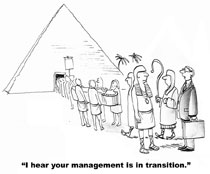Got Post Change Chaos?

There have been countless articles written on the importance of preparing for a merger or acquisition. There are models that can be utilized as guidelines for the integration of organizational cultures. How often is the information and even warnings heeded? Unfortunately more not than often. So what can be done after the merger for which there was insufficient or no preparation?
- First realize that it will not be easy and it will take time. Most humans do not embrace change. In fact, some behavioral styles will resent it, avoid it and even fight it making the job even more challenging. Having inadequate warning and time to adjust only makes matters worse. So bring your patience. Also, prepare to have your understanding stretched to the max. Think about it…how would you feel or handle it if your spouse said their mother is coming to live at your house next week giving you no time to prepare? I dare say, there would be some ensuing chaos.
- Help your managers handle employee bickering. Managers must avoid “getting hooked” into employee frays. Make sure that every leader conveys the proper chain-of-command for complaints. This is especially important for smaller organizations where employees have typically “gone to the top” person to vent. Now that the organization is larger, this is no longer feasible or practical with more people to manage.
- Offer training programs on respect, professional decorum, communication, and leadership. A merger requires both soft and technical skills for success.
- Provide managers with coaching tools. Understanding the right questions to ask an upset employee helps the employee to take ownership of his or her complaint. More often than not, the employee just wants someone to know he or she is upset. Helping employees to be more empowered in handling their own grievances saves time, reduces stress, and helps the employee develop both personally and professionally. Some workers carry their feelings on their sleeves or they may carry a chip on their shoulder. Providing training and coaching around this element of self-management can go a long way in reducing tension, disagreements, and stress.
- Personal Accountability. This self-management technique fits into the information above, but takes the idea to some specific actions. Several years ago, John Miller developed a program entitled “Personal Accountability and the QBQ.” The acronym “QBQ” stands for the Question Behind the Question. In other words, the idea is to help employees stop asking self-defeating or victim type questions and ask more powerful questions. Here are a few examples from John’s program:

 Complexity and how it affects productivity seems to be the new boogie man haunting organiztions. The reality is that research by Margaret Wheatly in 1994 and Olson and Eoyang in 2001 brought this Ghoul out of its closet. Needless to say, different factors from different business issues such as technology and the world economic and political stages have added their own unique twists to the complexity of doing business. One factor that has remained constant is people. Zimmerman (1998), as quoted in a study by Peter M. Dickens states, “In every interaction, people mutually adjust their behaviors in ways needed to cope with changing internal and external environmental demands.”
Complexity and how it affects productivity seems to be the new boogie man haunting organiztions. The reality is that research by Margaret Wheatly in 1994 and Olson and Eoyang in 2001 brought this Ghoul out of its closet. Needless to say, different factors from different business issues such as technology and the world economic and political stages have added their own unique twists to the complexity of doing business. One factor that has remained constant is people. Zimmerman (1998), as quoted in a study by Peter M. Dickens states, “In every interaction, people mutually adjust their behaviors in ways needed to cope with changing internal and external environmental demands.” Disclaimer. In no way is this article meant to condone the use of drugs, illegal or otherwise. Nor is this a campaign to state an opinion as to whether drugs that are currently illegal be made legal.
Disclaimer. In no way is this article meant to condone the use of drugs, illegal or otherwise. Nor is this a campaign to state an opinion as to whether drugs that are currently illegal be made legal. Every team member brings value to the table. Some team members are more tech savvy than others. Some are better at handling conflict than others. Some are better at problem solving. Some have a wide range of experiences, and on and on. Different talents cut across the generational spectrum. For example, while I’m no “whiz kid” when it comes to technology, I’ve met many far younger who are not as tech savvy as I am. Some younger people may have more experience at customer service than someone older. So let’s clear the table about what generation is better at one thing or the other.
Every team member brings value to the table. Some team members are more tech savvy than others. Some are better at handling conflict than others. Some are better at problem solving. Some have a wide range of experiences, and on and on. Different talents cut across the generational spectrum. For example, while I’m no “whiz kid” when it comes to technology, I’ve met many far younger who are not as tech savvy as I am. Some younger people may have more experience at customer service than someone older. So let’s clear the table about what generation is better at one thing or the other. According to the CEO Economic Outlook Survey Q2 2015, CEOs will begin cutting back on spending and start working on layoffs. Here we go again. The people who need the money will no longer be making any, families will suffer, and the economy will be taking another nose dive. An important question to ask is what will these layoffs, lack of people power, and lost revenues do to your organization? What if there were a more creative way CEOs could keep their employees working, save families, save their communities, save the economy, and boost their organization all at the same time?
According to the CEO Economic Outlook Survey Q2 2015, CEOs will begin cutting back on spending and start working on layoffs. Here we go again. The people who need the money will no longer be making any, families will suffer, and the economy will be taking another nose dive. An important question to ask is what will these layoffs, lack of people power, and lost revenues do to your organization? What if there were a more creative way CEOs could keep their employees working, save families, save their communities, save the economy, and boost their organization all at the same time?  Change is rarely easy. Transitions in leadership fall into the change arena and not only is it rarely easy, a CEO transition, whether planned or unexpected, can lead to chaos if not handled with care. If there are extenuating circumstances around the transition, life can become an out of control roller coaster with a broken stop button. As with any other change, there are ways to prepare for eventualities and prevent catastrophes.
Change is rarely easy. Transitions in leadership fall into the change arena and not only is it rarely easy, a CEO transition, whether planned or unexpected, can lead to chaos if not handled with care. If there are extenuating circumstances around the transition, life can become an out of control roller coaster with a broken stop button. As with any other change, there are ways to prepare for eventualities and prevent catastrophes. OK, right off the bat, I’m in trouble for linking kissing and the workplace. But I’m pretty certain that blowing up HR is frowned upon as well. Lately there have been cries to dismember HR in some way, by splitting it up, blowing it up, redesigning it, or doing away with it altogether. In fact, in a report by Deloitte, there is a gap “between what business leaders want and the capabilities of HR to deliver.” The report goes on to state that even HR gives its teams a grade of C-. Business leaders rate HR with a D I would relate the relationship between HR and leadership as that of teenagers and their parents. Here’s why.
OK, right off the bat, I’m in trouble for linking kissing and the workplace. But I’m pretty certain that blowing up HR is frowned upon as well. Lately there have been cries to dismember HR in some way, by splitting it up, blowing it up, redesigning it, or doing away with it altogether. In fact, in a report by Deloitte, there is a gap “between what business leaders want and the capabilities of HR to deliver.” The report goes on to state that even HR gives its teams a grade of C-. Business leaders rate HR with a D I would relate the relationship between HR and leadership as that of teenagers and their parents. Here’s why.